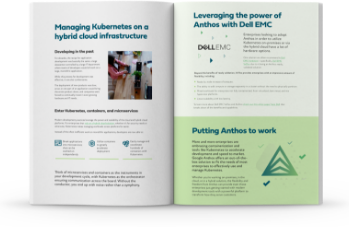BLOG
The latest in infrastructure, technology, and security
From emerging innovations to real-world applications, we cover what helps leaders navigate complexity, drive transformation, and make smarter decisions in a rapidly evolving landscape.
How to increase agility and speed to market by combining Google Anthos and Dell EMC
According to a 2019 report from McKinsey Digital, 71% of CEOs named improved agility and faster time to market as top priorities.
That percentage was just below revenue acceleration (88%) and above cost reduction (47%) on the list of priorities. The reason the number is so high is because CEOs recognize that in order to remain competitive and meet customer expectations, their enterprises need to be able to adapt to the ever-changing market. But if increasing agility and speed to market are the goals, for many, the act of actually achieving those goals can be elusive.

For large enterprises in particular, who aren’t exactly known for their ability to adjust quickly, adopting new ways of developing products and services can be a challenge.
Some of the roadblocks these enterprises often encounter include:
On this page, you will learn how you can alleviate these pain points.

Click here to download this page as a PDF to refer to later.
Download Page as PDF
For decades, the recipe for application development was basically the same: a large datacenter controlled by a large IT department where teams of developers would all work on a large, monolithic application.
While this process for development was effective, it was also cumbersome.
The deployment of new products was slow, errors in one part of an application would bring the entire product down, and companies were forced to continually invest in ever-growing hardware and IT needs.
Modern development practices leverage the power and scalability of the cloud and hybrid cloud platforms. For enterprises that rely on a hybrid cloud solution, whether it’s for security needs or otherwise, Kubernetes makes managing workloads across platforms far easier.
Instead of the often inefficient work on monolithic applications, developers are now able to:
Think of microservices and containers as the instruments in your development cycle, with Kubernetes as the orchestrator ensuring communication across the board. Without the conductor, you end up with noise rather than a symphony.

An open hybrid multi-cloud application platform, Google Anthos has been created in order to help enterprises securely modernize, build, and run applications regardless of where that work is being done.
For enterprises looking to adopt a hybrid cloud solution in particular, Anthos delivers a robust suite of tools to help make managing workloads across platforms as painless as possible.
It’s important to note that while Anthos is designed to assist in the transition to hybrid multi-cloud platforms, it’s not in itself a strategy to do so. Instead, it’s a tool to make utilizing those platforms—and the modern development processes that benefit from them—easier once they’re up and running.
If you want help creating a roadmap to hybrid multi-cloud, click here to contact one of our experts.

Enterprises looking to adopt Anthos in order to utilize Kubernetes on-premises or via the hybrid cloud have a lot of hardware options.
One solution we often recommend is Dell EMC hardware—specifically, Dell EMC VxFlex due to it being an Anthos-ready, validated solution.
Beyond the benefits of ready validation, VxFlex provides enterprises with an impressive amount of flexibility, including:
To learn more about Dell EMC VxFlex and Anthos check out this whitepaper from Dell that breaks down all the benefits and capabilities.

Click here to download this page as a PDF to refer to later.
Download Page as PDF
More and more enterprises are embracing containerization and tools like Kubernetes to accelerate development and speed to market. Google Anthos offers an out-of-the-box solution to fit the needs of most enterprises to effectively use and manage Kubernetes.
Whether you’re working on-premises, in the cloud, or in a hybrid solution, the flexibility and freedom from Anthos can provide even those enterprises just getting started with modern development tools with a powerful platform to transform how they serve customers.
Redapt can help your organization integrate a solution that brings together software and hardware to deliver a functioning Anthos environment. Then you’ll be able to leverage:
Contact one of our experts to learn more about Anthos or get assistance in developing a roadmap to containerization and adopting Kubernetes.
Watch a replay of Redapt experts Vishnu Arunachalam and Matt Francis discussing how your enterprise can leverage Kubernetes on-premises or in the hybrid cloud.